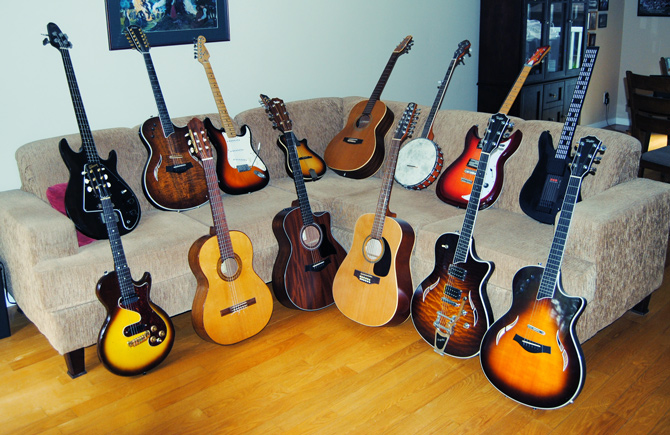Sometime around 1975, I found myself in Treble Clef Records on the Sparks Street mall in Ottawa, the only significant record shop in the area at that time, which unfortunately went out of business a few years later. I had money in my pocket and was leafing through their collection of “long-playing” (LP) records lined up against the wall when I came across the LP pictured at the right. It said “Mississippi Country Blues by Jack Owens and Bud Spires” and had a nice photo of Jack Owens and his horse on the cover! I had no idea who Jack Owens or Bud Spires were but Mississippi Country Blues was right down my alley. The title was enough to stop me right there – “It Must Have Been The Devil.” I was raised Catholic and I knew many dreadful tales about “the Father of Lies”, more so since I was an avid horror movie enthusiast, where Mephistopheles frequently showed up uninvited. I couldn’t resist and bought the album on the spot.
When I listened to the LP at home, I loved the laid-back sound of the songs but the title song, “It Must Have Been The Devil”, stood apart from all the others. Its tonalities, harmonies and resonance were haunting. For more than nine minutes, the guitar kept weaving hypnotic patterns and Jack Owens’ powerful, all-out vocal was like a force unleashed, unlike any other singer I knew. This was some of the eeriest, loneliest and deepest blues sounds I’d ever heard.
Of course, I tried to learn the song but all I could get was that it’s in the key of E! At that time, I knew just about every open guitar tuning that existed, thanks to Bert Jansch, Davey Graham, John Renbourn and all those tremendously talented guitarists that had spearheaded the British Celtic Revival. I tried and tried but I could not play the notes Jack Owens played in any tuning that I knew! Facing a brick wall, I eventually discarded the song, extremely disappointed that I had failed at discovering its secrets. Years went by and my Jack Owens/Bud Spires LP remained stored in my voluminous collection, out of sight and out of mind.
Fast forward many years to the digital age and the seemingly endless amount of information available to us at the click of a mouse. I had heard Skip James during the 60s Folk and Blues Revival and I learned that he was from Bentonia, Mississippi and played his guitar in an open D Minor tuning (sometimes called “crossnote tuning), which was extremely odd since the songs he sang were all in major keys! To hear me play Skip James’ classic “Hard Time Killing Floor Blues” in crossnote tuning and to learn more about Skip James, click here.
Crossnote tuning originally came from Henry Stuckey, an unrecorded bluesman who had learned it from Bahamian soldiers while stationed in France during World War I. He brought it home to Bentonia after the war, a town of less than 500 people located on the edge of the Delta, between Jackson and Yazoo City, Mississippi. All the bluesmen from Bentonia eventually ended up playing their guitars in this crossnote tuning. Henry Stuckey taught the tuning to Skip James, who taught it to Jack Owens who, more recently, taught it to Jimmy “Duck” Holmes. Skip James was certainly the most famous of these artists and it is fairly certain that he also taught the tuning to Robert Johnson, who used it to play his composition “Hellhound On My Trail.”
“It Must have Been The Devil” has a chronology of its own and the song changed over the years. It was first recorded by Skip James in 1931 under the title “Devil Got My Woman.” These early recordings, made in the midst of the Great Depression, sold poorly and drifted into obscurity, as did James himself. James was rediscovered in 1964 and made new recordings of most of his repertoire, including ‘Devil Got My Woman.” He died in 1969 at the age of 67 and the following year, musicologist David Evans met Jack Owens during a field trip to Bentonia. In 1970, he recorded Owens and blues harp player Bud Spires playing a number of songs on Owens’ porch, including the landmark recording of “It Must Have Been The Devil”, a song about isolation, betrayal and the supernatural. Evans was later quoted as saying “Hearing Jack Owens singing out across the fields late at night is one of the most moving experiences I have ever had.”
Owens did not seek to become a professional recording artist. He farmed, sold bootleg liquor, and ran a weekend juke joint in Bentonia for most of his life. Originally set in Owens’ home, the juke joint became so popular that it moved to a separate and larger house across the street. Festivities lasted from Friday evenings until Sunday mornings, with non-stop barbecue, bootleg, music and dancing. Sometimes the music came from Owens’ own juke box, but it was mostly played by Owens and Spires themselves. Jack Owens learned to play especially for the raucous dancers at his juke point, using a thumb pick to be heard above the din of the celebrations, stomping his boots on the floor for rhythm. He played on any battered instrument he could find, even an old 12-string guitar body fitted with the usual six strings, sometimes using a pencil clamped over the strings with elastics for a capo. Over the years, Evans recorded Owens playing in seven different guitar tunings.
Jack Owens died in 1997 at the ripe old age of 92, a tribute to the restorative qualities of bootleg, barbecue and the blues.
Richard Séguin – voice, acoustic guitar, percussion (foot)
